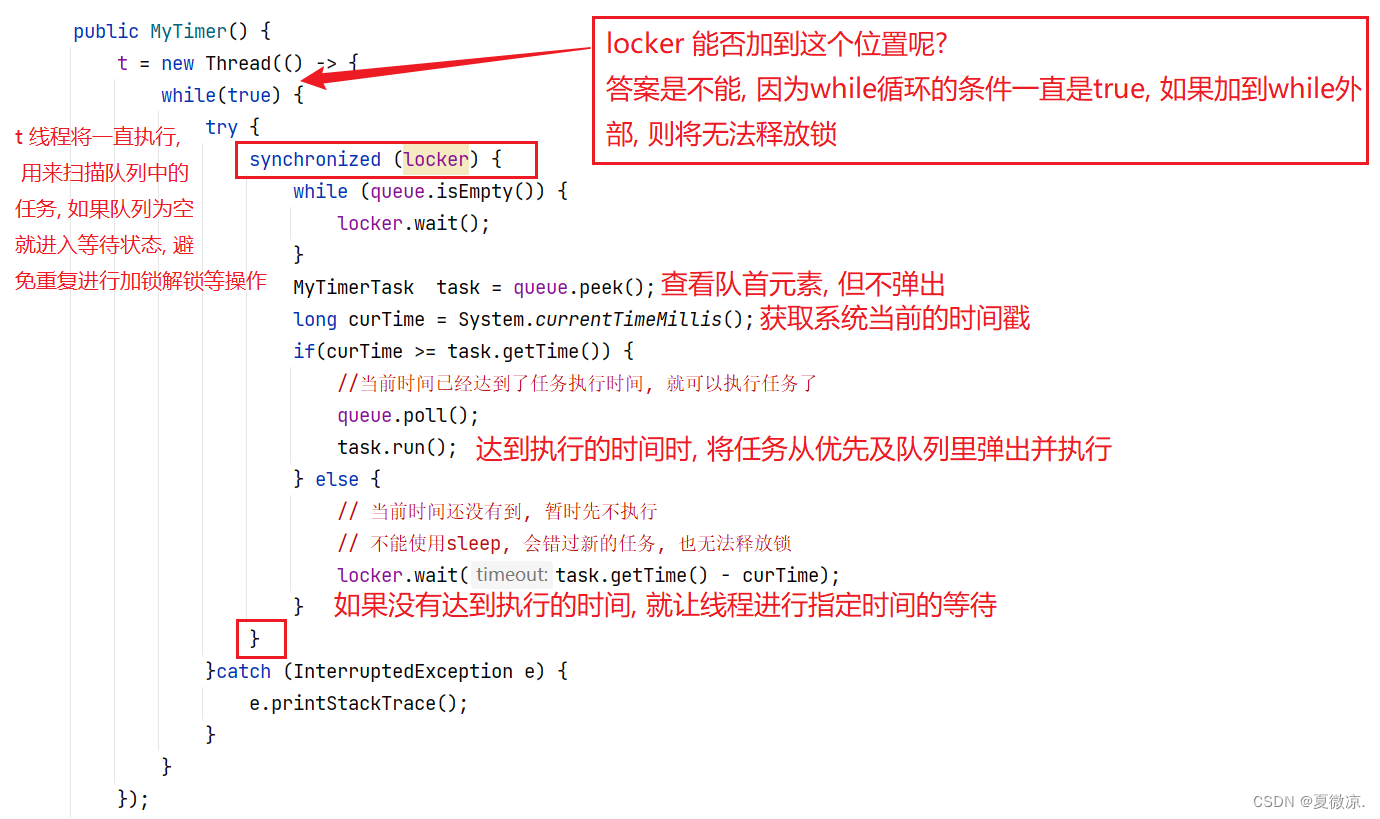【JavaEE】多线程(6) -- 定时器的使用及实现

目录
定时器是什么
Java中的定时器是一种机制,用于在预定时间执行某个任务。它允许开发人员在指定的时间间隔内重复执行任务,或在指定的延迟之后执行任务。定时器是Java提供的一种方便的工具,用于处理需要定期执行的任务,例如定时任务调度、定时数据备份等。
定时器也是软件开发中的?个重要组件. 类似于?个 "闹钟". 达到?个设定的时间之后, 就执?某个指定好的代码

定时器是?种实际开发中?常常?的组件.
?如?络通信中, 如果对? 500ms 内没有返回数据, 则断开连接尝试重连.
?如?个 Map, 希望??的某个 key 在 3s 之后过期(?动删除).
类似于这样的场景就需要?到定时器.
标准库中的定时器的使用
标准库中提供了?个 Timer 类. Timer 类的核心方法为 schedule .
schedule 包含两个参数: 第一个参数指定即将要执行的任务代码, 第?个参数指定多长时间之后执行 (单位为毫秒).
public static void main(String[] args) {
Timer timer = new Timer();
timer.schedule(new TimerTask() {
@Override
public void run() {
System.out.println("hello 3000");
}
},3000);
timer.schedule(new TimerTask() {
@Override
public void run() {
System.out.println("hello 2000");
}
},2000);
timer.schedule(new TimerTask() {
@Override
public void run() {
System.out.println("hello 1000");
}
},1000);
System.out.println("hello main");
}?
第一个任务在3000毫秒(3秒)后执行,它的run方法会打印出"hello 3000"。
第二个任务在2000毫秒(2秒)后执行,它的run方法会打印出"hello 2000"。
第三个任务在1000毫秒(1秒)后执行,它的run方法会打印出"hello 1000"。?
实现定时器
定时器的构成
? ?个带优先级队列(不要使用?PriorityBlockingQueue, 容易死锁!)
? 队列中的每个元素是?个 Task 对象.
? Task 中带有?个时间属性, 队首元素就是即将要执行的任务
? 同时有?个 worker 线程?直扫描队首元素, 看队首元素是否需要执行
创建以下两个类来实现定时器的功能:
1. MyTimer 类提供的核?接?为 schedule, ?于注册?个任务, 并指定这个任务多?时间后执?.
class MyTimer {
public void shedule(Runnable runnable, long delay) {
}
}2. Task 类?于描述?个任务(作为 Timer 的内部类). ??包含?个 Runnable 对象和?个 time(毫秒时 间戳) 这个对象需要放到优先队列 中. 因此需要实现 Comparable 接?
class MyTimerTask implements Comparable<MyTimerTask> {
public MyTimerTask(Runnable runnable, long delay) {
}
public void run() {
runnable.run();
}
@Override
public int compareTo(MyTimerTask o) {
return (int)(this.time - o.time);
}
}Runnable是Java中一个非常重要的接口,它是一个函数式接口,用于定义线程的任务。Runnable接口只包含一个抽象方法run(),该方法是线程的入口点,线程在执行时会调用run()方法中的代码。?
下面是具体的实现过程:
//通过这个类来描述一个任务
class MyTimerTask implements Comparable<MyTimerTask> {
//time是一个 ms 级别的时间戳
private long time;
//实际任务要执行的代码
private Runnable runnable;
public long getTime() {
return time;
}
public MyTimerTask(Runnable runnable, long delay) {
this.runnable = runnable;
//计算一下真正要执行任务的绝对时间, 使用绝对时间,方便判定任务是否达到时间
this.time = System.currentTimeMillis() + delay;
}
public void run() {
runnable.run();
}
@Override
public int compareTo(MyTimerTask o) {
return (int)(this.time - o.time);
}
}
//通过一个类表示一个任务的进程
class MyTimer {
// 负责扫描任务队列, 执行任务的线程
private Thread t = null;
//任务队列
private PriorityQueue<MyTimerTask>queue = new PriorityQueue<>();
//锁对象
private Object locker = new Object();
public void shedule(Runnable runnable, long delay) {
synchronized (locker) {
MyTimerTask task = new MyTimerTask(runnable,delay);
queue.offer(task);
//添加新的元素后, 就可以唤醒扫描线程的 wait 了;
locker.notify();
}
}
public void cancel() {
// 结束t线程
// interrupt
}
//构造方法, 创建扫描线程, 让扫描线程来完成判定和执行
public MyTimer() {
t = new Thread(() -> {
//扫描线程就需要循环反复的扫描队首元素, 然后判定队首元素是不是时间到了
//如果时间没到, 啥都不干
//如果时间到了, 就执行这个任务并且把这个任务从队列中删除掉
while(true) {
try {
synchronized (locker) {
while (queue.isEmpty()) {
locker.wait();
}
MyTimerTask task = queue.peek();
long curTime = System.currentTimeMillis();
if(curTime >= task.getTime()) {
//当前时间已经达到了任务执行时间, 就可以执行任务了
queue.poll();
task.run();
} else {
// 当前时间还没有到, 暂时先不执行
// 不能使用sleep, 会错过新的任务, 也无法释放锁
locker.wait(task.getTime() - curTime);
}
}
}catch (InterruptedException e) {
e.printStackTrace();
}
}
});
t.start();
}
}在 MyTimer 的构造方法中, 需要注意加锁的位置:


本文来自互联网用户投稿,该文观点仅代表作者本人,不代表本站立场。本站仅提供信息存储空间服务,不拥有所有权,不承担相关法律责任。 如若内容造成侵权/违法违规/事实不符,请联系我的编程经验分享网邮箱:chenni525@qq.com进行投诉反馈,一经查实,立即删除!
- Python教程
- 深入理解 MySQL 中的 HAVING 关键字和聚合函数
- Qt之QChar编码(1)
- MyBatis入门基础篇
- 用Python脚本实现FFmpeg批量转换
- python实现图像的二维傅里叶变换——冈萨雷斯数字图像处理
- 揭露欧拉骗局5.构建函数1/n>ln(1+1/n)公开作弊
- 指针大魔王(中)
- ZooKeeper 实战(四) Curator Watch事件监听
- js实时监听input输入框值的变化
- FA1612AS (MHz范围晶体单元,内置热敏电阻)
- 软件设计师——计算机组成原理(三)
- 【Go面试向】Go程序的执行顺序
- SpringBoot多环境配置Maven Profile组
- 基于SSM的养老院系统管理设计与开发-计算机毕业设计源码 64996